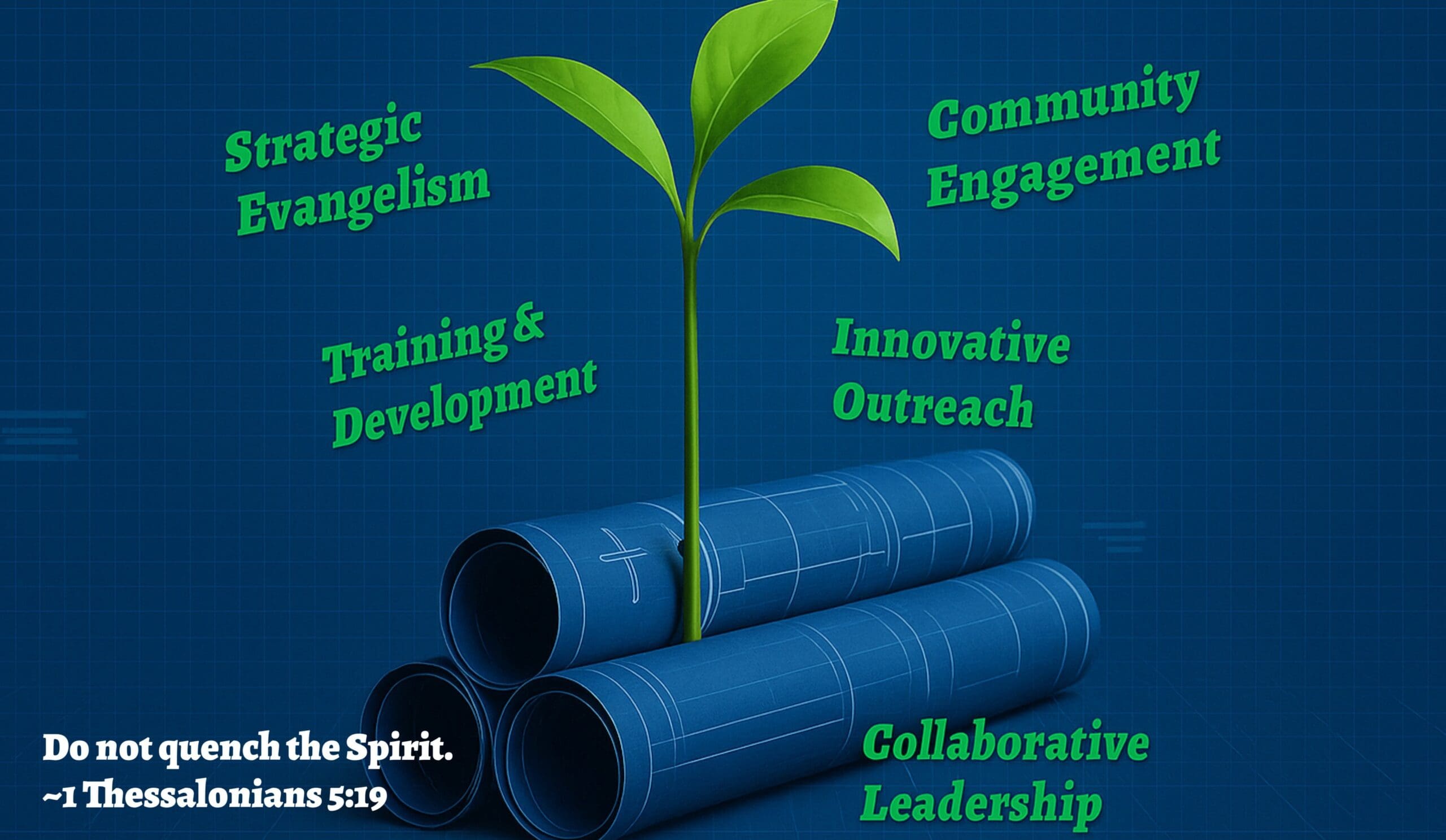In June, I reflected on my roots in Fort Valley, Georgia, and the leadership lessons I learned as a young Boy Scout. This month, I want to share my thoughts on where we are headed. The future of the Christian Methodist Episcopal Church depends not only on remembering our past but also on building ministries that are visionary, strategic, and Spirit-led. Throughout my 40+ years of ministry, I have experienced both successes and failures, particularly in my early years as a pastor. Many of my failures came from relying solely on preaching ability, theological knowledge, and charisma without a clear strategy for ministry growth and transformation. Along the way, I discovered that my most successful church assignments were guided by five foundational pillars, which I have shared throughout my campaign for General Secretary of Evangelism and Missions:
- Strategic Evangelism
- Innovative Outreach
- Collaborative Leadership
- Training & Development
- Community Engagement
These pillars are not merely theories from books; they are rooted in real-life experiences gained during both the valley and mountaintop seasons of ministry.
Growth From Business Principles
When I was an entrepreneur running my own design and consulting business in Georgia, I often referred to the “Five Ps” of marketing—Product, Price, Place, Promotion, and People—as essential components of a successful business strategy. If any one of these is missing or poorly executed, the overall impact is weakened (Kotler & Armstrong, 1991). For example, you may have a great product, but if no one knows about it (Promotion) or can find where to buy it (Place), it won’t sell. Likewise, suppose a product is well-promoted but lacks quality (Product). In that case, the excitement will lead to disappointment, and nowadays, a bad review on Google Reviews, Yelp, the Better Business Bureau, or social media can be detrimental. Unfortunately, I have come across some churches with negative reviews.
You could have the right product, place, and promotion, but if the price is too high, people may walk away. If it’s too low, you undercut your sustainability. And if you ignore the people you’re trying to reach or fail to serve them well, the entire strategy will collapse. Ministry is no different. Just like in marketing, all parts must work together in harmony to build a thriving church. I am convinced that our churches must embrace all five foundational pillars to grow spiritually, financially, and numerically:
- Strategic Evangelism sets a clear message and mission.
- Innovative Outreach creates new ways to connect with people.
- Collaborative Leadership builds teams that carry the vision forward.
- Training & Development equips the saints for the work of ministry.
- Community Engagement builds relationships that keep the church visible and relevant.

Developers don’t build malls, apartments, or homes at random. Before breaking ground, they carefully evaluate the land, analyze community needs, review zoning regulations, consider population trends, and assess the project’s long-term sustainability. In the same way, ministry leaders must be intentional when asking, “Where does the Church grow next?” As the Church, we are called to prayerfully examine our ministry climate, understand community needs, and align growth with Kingdom priorities. Ministry expansion should not be based on impulse or tradition but on discernment, data, and the guidance of the Holy Spirit.
The five foundational pillars function as our spiritual zoning plan, architectural blueprint, and construction timeline, working together to build thriving, Spirit-led ministries. You may have a great ministry, but if no one knows about your church (Promotion) or can find its location (Place), it won’t attract people. Likewise, your church can be well-promoted on social media, but if it lacks the five foundational pillars when people arrive, the initial excitement will turn into disappointment, and they will not return. Not only will people fail to return, but you will also struggle to attract new people from the community.
Growth From Ministry Experience
Some theologians reading this may wonder: Where do theological knowledge, profound preaching, and administrative skills fit within these five pillars? The answer is that they are vital, but on their own, they are not sufficient to sustain a healthy, thriving ministry. Theological knowledge shapes our doctrine and fuels Strategic Evangelism. Powerful preaching drives Innovative Outreach, connecting hearts and minds to God’s truth. Strong administrative skills support effective Training & Development, ensuring systems are in place to equip the saints. When combined with prayerful Collaborative Leadership and meaningful Community Engagement, ministry can thrive. But let’s be clear: without the Holy Spirit, even the best-designed plan will lack power. The five pillars do not replace spiritual gifts or doctrinal depth; instead, they provide a framework to organize, execute, and multiply those gifts for greater Kingdom impact.
As an Evangelism Director for over 30 years, I’ve visited many lifeless churches, places where the Spirit seemed absent. Not because God was unwilling to be there, but because the church was not welcoming, yielding to, or recognizing the movement of the Spirit. A church can have a strong structure, rich tradition, and many programs, and still lack spiritual vitality. When services become purely ritualistic and leaders operate in their own strength without prayer, discernment, or openness to the Spirit, they quench the fire that fuels transformation. As 1 Thessalonians 5:19 (NIV) says, “Do not quench the Spirit.”
During my decades of service on Ministerial Examination Boards in the CME Church—both in Georgia and Texas, including six years as Chair of the Dallas-Fort Worth/Northwest Region of the 8th Episcopal District, I’ve met many young and new preachers who were sincere and gifted, believing their seminary degrees and preaching abilities would automatically transform churches. I’ve also encountered highly anointed preachers who could “preach circles around anyone” with Spirit-filled sermons, yet lacked formal theological training or the administrative leadership skills needed to build effective ministries. Many assumed their special anointing alone would turn ministries around. However, these eager preachers often ran into a brick wall upon arriving at congregations that were tired, grieving, frustrated, or hurt.
Growth From Spirit-Led Leadership
A lifeless church doesn’t just affect attendance; it impacts the souls of its members and their pastor. It discourages those hungry for the Word, disorients seekers, and drains the passion of those called to lead. The good news is that revival is always possible. When churches return to prayer, welcome the Holy Spirit, and rediscover their purpose, God can breathe life into dry bones again (Ezekiel 37:1–14). Like many of these preachers, I once believed my education and energy were enough. However, I learned that real transformation requires more than just knowledge and charisma. It demands a Spirit-led, strategic plan rooted in the five foundational pillars.
You may not be able to implement all five pillars at once, especially if your congregation is small, but transformation is a layered process. Start with one, build momentum, and move to the next. Just as architects begin with a blueprint, we must be intentional in constructing the next chapter of our Church’s evangelism and missions. You must ask yourself: Where are we now? And where does the Church grow next? As a candidate for General Secretary of Evangelism and Missions, I believe these pillars are essential for growth, impact, and sustainability.

In their book “Teams That Thrive: Five Disciplines of Collaborative Church Leadership”, Ryan T. Hartwig and Warren Bird highlight a powerful truth: “If you want to go fast, go alone. If you want to go far, go together.” This African proverb captures the heart of collaborative leadership. While quick results may come from solo efforts, lasting transformation occurs when we build together through shared vision, shared leadership, and shared purpose. As we enter Annual Conference season, I encourage you to pause, reflect, and ask: Where will my church grow next? Let’s grow together.
Call to Action
- Make an Honest Assessment: Which of the five pillars is thriving? Which needs immediate attention?
- Pray for Direction: No strategy can succeed without the power and presence of the Holy Spirit.
- Create Space for Collaborative Leadership: Empower voices across generations, backgrounds, and spiritual gifts.
- Invest in People: Equip members to lead, serve, and disciple others.
- Step Outside the Walls: Build meaningful connections through innovative outreach to show your ministry is relevant, compassionate, and present.
References
Kotler, P., & Armstrong, G. (1991). Principles of marketing (5th ed.). Prentice Hall.
Hartwig, R. T., & Bird, W. (2015). Teams that thrive: Five disciplines of collaborative church leadership. InterVarsity Press.




